1899 1 Dollar Silver Certificate “Black Eagle”
Here is an 1899 “Black Eagle” Silver Certificate, which, as the clause at the top center states, this note was backed by an actual dollar’s worth of silver. You could take this to the US Treasury and redeem it for a silver dollar if you wished. Silver Certificates were issued until 1963, and in 1964 redemption for silver was ended. Like all federally issued banknotes, silver certificates continued to be, and are still today, legal tender. At right you can see the redemption clause – what the note could officially be spent on.
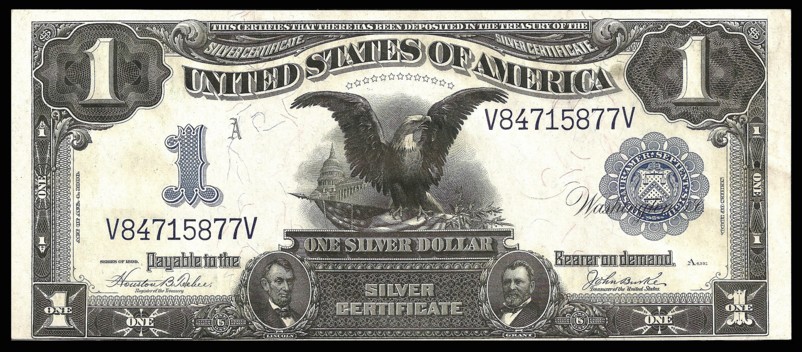

1917 1 Dollar Legal Tender Note
Next up is a 1917 United States Note, also referred to as Legal Tender Notes. Legal Tender Notes are among the oldest types of circulating U.S. banknotes and were introduced during the Civil War. These were direct obligations of the government and thus were pieces of the national debt. The vignette on the left side of the front is by Charles Schussele and is called “Columbus’ Discovery of Land”. This vignette is also on the back of the large-size 1914 5 dollar Federal Reserve Note found on the 5 dollar page.


1918 1 Dollar National Currency
A 1918 Federal Reserve Bank Note, also called National Currency. A subtype of the Nationals, Federal Reserve Bank Notes were issued by Federal Reserve Banks, but unlike ordinary Federal Reserve Notes, these Federal Reserve Bank-Notes were direct obligations of the issuing Federal Reserve Bank, not the U.S. government. Look at the front and you’ll see that the note is backed by securities of indebtedness or one-year gold notes deposited in the treasury.
A 1918 Federal Reserve Bank Note, also called National Currency. A subtype of the Nationals, Federal Reserve Bank Notes were issued by Federal Reserve Banks, but unlike ordinary Federal Reserve Notes, these Federal Reserve Bank-Notes were direct obligations of the issuing Federal Reserve Bank, not the U.S. government. Look at the front and you’ll see that the note is backed by securities of indebtedness or one-year gold notes deposited in the treasury.


1923 1 Dollar Legal Tender “Horse Blanket”
A 1923 United States Note, or Legal Tender Note. This design change from the 1917 Legal Tender note was concurrent with the Silver Certificate following this note, however, these Legal Tender Notes are more scarce than Silver Certificate type below. This note’s reverse design is popularly referred to as a ‘Horse Blanket’.
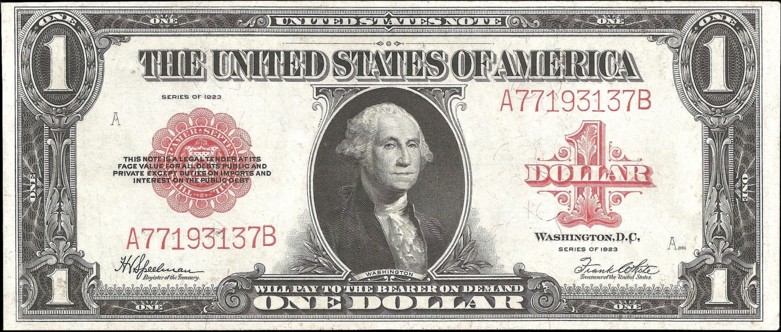

1923 1 Dollar Silver Certificate “Horse Blanket”
Below is a 1923 Silver Certificate. These were backed by silver coin, and were redeemable for silver at the Treasury. Production of Silver Certificates stopped in 1963, with a deadline of June 24, 1968 imposed for redemption. Silver Certificates still in circulation are no longer redeemable in silver, but remain legal tender. The 1923 is known as a “Horse Blanket” due to the design on the reverse.
The differences between the two notes is not all very obvious. The Legal Tender Note has red color on the seals, denomination at right and the serial numbers, which is the most striking. The declaration of the “United States Note” type at top is of course different than the “Silver Certificate”. Look closer and you can see that the Silver Certificate has an additional obligation above “The United States of America” which is continued below the portrait of Washington. The obligation stamped over the treasury seals is different too. The red seal’s obligation reads: “This note is legal tender at its face value for all debts public and private except for duties on imports and interest on the public debt”. The obligation over the blue treasury seal reads: “This certificate is receivable for customs, taxes, and all public dues and when so received may be issued”. The notes were backed by separate government funds and the Legal Tender note had a limitation placed on certain payments for duties, imports and interest on public debt. Most people were not concerned with these matters however, and both notes circulated together and spent equally well at the stores.

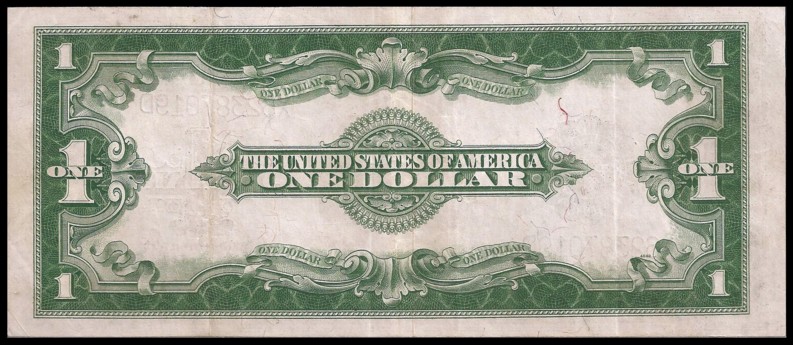
1928 1 Dollar Silver Certificate “Funny Back”
Next up is a 1928 Silver Certificate. The size of all banknotes was reduced beginning in 1928. This is a small-size note that begins to resemble what we use today on the front. The back design is known as a “Funny Back”, incorporating the “Horse Blanket” design of the 1923 Large Size note.

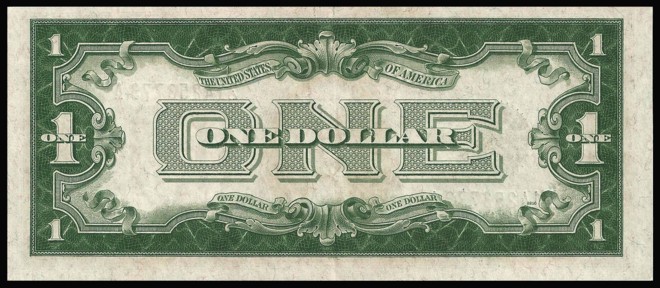
1928 1 Dollar Legal Tender “Funny Back”
This United States Note, also known as a Legal Tender Note, was printed in only one series, 1928. Even though it has that date, it wasn’t printed until 1933. The fact is that the dates on banknotes are not like coins. The dates are grouped in Series and reflect the last time the notes underwent a design change at the Bureau of Engraving and Printing. These Legal Tender notes are direct obligations of the United States, and were in production for only about two months when it became apparent that there was not much of a need for them. Only 1,872,012 notes were printed, a very low number for a print run. Of those only 5,000 notes were actually released into the contiguous United States, the vast majority were put aside in the treasury until they were finally issued in Puerto Rico about 1949. Because so few of these red seal $1 small size notes were printed, they command a nice strong premium among collectors.
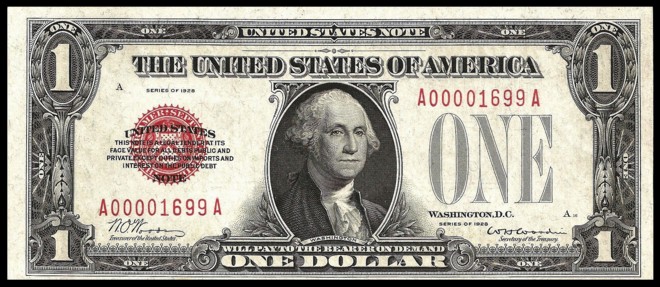

1934 1 Dollar Silver Certificate “Funny Back”
In 1934 there was a design change on the front of the $1 bill. Here you can see that the blue Treasury Seal is now on the right and under the word ONE, while the left side has a blue tinted 1 and the redemption clause is shortened. The certificate states at top that “there is on deposit” instead of “there has been deposited”, and at the bottom it changed from “One Silver Dollar” to “One Dollar in Silver” . This design lasted only for 1 year.


1935 1 Dollar Silver Certificate
Even closer to what we use to today is the next note, a 1935 Silver Certificate. The design of this note added the One Dollar designation under the top right serial number and changed the design of the left numeral 1 under the redemption clause. The reverse still lacks the “In God We Trust” motto we have today.


1935A 1 Dollar Silver Certificate “Experimental R and S”
These notes are 1935A Experimental Note. During World War II, there was concern that there may be a shortage of materials to make paper money. In 1944, there were two experimental notes issued in this series, one with a red R which was a control group made of regular paper, and one with a red S, which was the Special note with the experimental paper, treated with a melamine compound in hopes of increasing the strength and durability of the paper. 1,184,000 of each type were made and released to the public to test the durability of the Special notes compared to the Regular notes. Reports on this experiment state that it didn’t produce any worthwhile data, but collectors love the nice, red letters on these notes. An article in the SPMC journal Paper Money No. 318 by Jamie Yakes, further states that there were numerous issues with redemption and collection for reviewing the notes by the Treasury department. Eventually the process was deemed unsuitable for intaglio printing, and the entire experiment was cancelled in 1946.
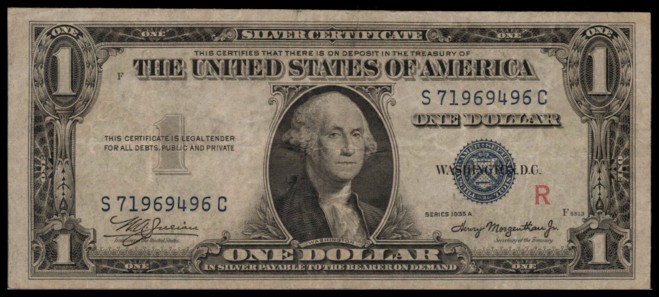

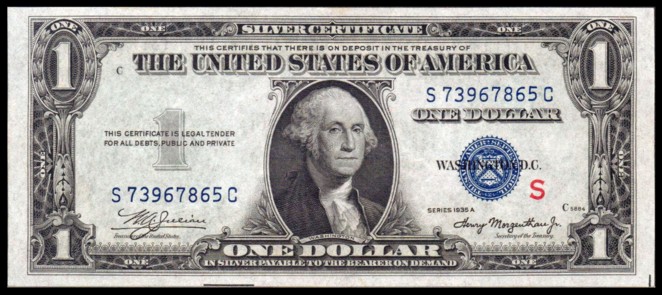

1935A 1 Dollar Silver Certificates in WWII
“Hawaii” and “North Africa”
These next two are oddballs. The first one is a Silver Certificate with “Hawaii” stamped on the front and back, and a brown seal. This was used during WWII, and the thought was that if Japan seized the islands, the US could quickly render these designs invalid, and keep the Japanese from using them. Similar concerns led to the use of the bottom note in North Africa for this purpose as well, but with a yellow seal and no overprint.
In Hawaii, the one dollar note was a silver certificate, while all the other notes issues with the Hawaii overprint ($5, $10 and $20 notes), were Federal Reserve notes. At the time, no one dollar FRN’s were being printed. Denominations over $20 were not used in Hawaii.
In North Africa, all issues were Silver Certificates and included the $1, $5, and $10 only.




1935G Silver Certificates with and without motto
Beginning in 1957 the Bureau of Engraving and Printing began printing the “In God We Trust” motto on the back of the One Dollar notes. Remember that Banknotes aren’t dated like coins, and the series dates reflect the last time the notes underwent a design change. So in 1957 the notes were dated series 1935 G. This changeover pair of the series 1935 G Silver Certificates placed the motto over the ONE on the back of the banknote. The change in design weren’t on all series 1935 G notes, but they were on all series 1935 H and later notes.
The motto had been introduced on US coins beginning in 1864.




As the price of silver rose, the government decided to abandon the Silver Certificates, and in November 1963 the last silver certificates were printed. In 1964 silver backed currency officially ended in the USA when the Treasury Secretary issued an order to stop redemption of silver certificates for silver, though they were still legal tender for $1. Silver would be removed U.S. coinage production in 1965. The creation of a new Federal Reserve One-Dollar Banknote replaced the older Silver Certificate, and the world kept on spending.
1963B 1 Dollar Federal Reserve Note “Barr Note”
This next note is a 1963B series note, commonly known as a “Barr Note” after the signature of the Secretary of the treasury Joseph W. Barr on the lower right. Joseph Barr was serving as the Undersecretary of the treasury from 1965-1968. At that time the Secretary was Henry F. Fowler. But Mr. Fowler resigned his position in December 1968 and became a partner of the Goldman Sachs firm. President Lyndon B. Johnson appointed Joseph Barr as the Secretary of the Treasury for the last month of President Johnson’s presidency. So Joseph Barr has the distinction of serving the shortest term of any Secretary of the Treasury – December 21, 1968 to January 20, 1969. As the secretary, his signature was to be printed on the currency, but as there was only one month left, only the One Dollar denomination was being printed, and the only denomination to bear his signature. It was thought that this fact would make the $1 bill quite scarce and valuable, so many people held onto them in hopes that they would increase in value. With a circulating lifespan of 21 months, this might have been, but most people didn’t realize just how many $1 bills could be printed in one month: 458,880,000 bills were printed with Joseph Barr’s signature. A “small” number in comparison to a regular printing, but the number of bills kept by collectors and investors ensure that there are still plenty of Barr Notes available today, at a very modest premium to collectors.


1995 1 Dollar Federal Reserve Note “Web Press Note”
The note above is a Web Press Note. This is a federal Reserve Note that is an experimental issue that used a different type of printing process. These were issued to the public, and were rarely noticed by the common user. The main differences are the tiny numbers on the lower right front and above the letter “E” in the “ONE” on the back of the banknote.


1999 1 Dollar Federal Reserve Note
Next is our modern US $1. Federal Reserve Notes were first issued in 1914 and are backed by the U.S. government but issued by Federal Reserve Banks, which are required to maintain enough assets to balance all the notes issued. Small-size Federal Reserve Notes have green seals and serial numbers. These are different than the Federal Reserve Bank Notes, which were obligations of the Issuing Federal Reserve Banks. Changes from the Silver Certificates include the denomination with the Treasury Seal is spelled out, front border changes, Federal Reserve seal on the left with letter designations coupled with numbers etc. are quite noticeable.

